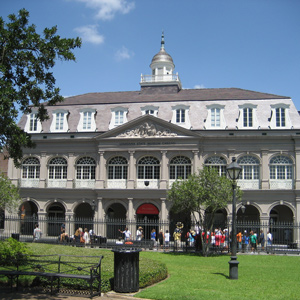Carlos Dehault Delassus
Date and artist unknown. Courtesy Missouri Historical Society, https://collections.mohistory.org/resource/145796.
Portrait caption:
“Marquis Charles de Hault de Lassus
Last Spanish Governor of Upper Louisiana”
Carlos Dehault Delassus served as the Spanish lieutenant governor of Upper Louisiana and resided in St. Louis at the time the Lewis and Clark Expedition wintered there in 1803–04. In December 1803, he refused permission for the expedition to go up the Missouri without first consulting his superiors. That permission came on 28 January 1804.
Delassus’s most important role was to organize the transfer of Upper Louisiana to the United States, which was accomplished on 9 and 10 March 1804 via Amos Stoddard acting in a duel role as French and American representative. Two days later and at the request of Stoddard, Delassus delivered a speech to the Indians informing them of the transfer of Upper Louisiana to the United States. The speech was witnessed by Lewis.
Selected Pages
November 30, 1803
Spain cedes Louisiana


In New Orleans, Pierre-Clément de Laussat has a parade and signs papers that officially cede the Louisiana Province from Spain to France. In Illinois, Lewis and Clark work at Fort Kaskaskia..
December 7, 1803
Cahokia arrivals


Lewis travels by land and Clark by river to arrive at Cahokia, Illinois. Lewis meets John Hay and Nicholas Jarrot who help him negotiate with the Spanish Lt. governor of Upper Louisiana.
December 8, 1803
Spanish resistance


On this or the previous day, Lewis meets with Dehault Delassus, the Spanish Lt. Governor of Upper Louisiana, and all agree that the expedition should spend the winter near Cahokia.
January 15, 1804
Intoxicated helpers


In a letter to his brother-in-law, Clark describes his situation at Rivière à Dubois—present Wood River. Several men and a wagon—all loaded with whiskey—appear at camp, and the weather is clear and cold.
January 28, 1804
Spanish obstacles removed


In his field notes, Clark records each hour at winter camp across from the mouth of the Missouri. The Spanish governor of Louisiana formally allows the expedition to proceed up the Missouri River.
February 19, 1804
Transfer orders


On or near this date in St. Louis, the Spanish Lieutenant Governor Dehault Delassus receives orders to transfer the Upper Louisiana Territory to Captain Amos Stoddard.
February 24, 1804
"a great Dinner & porrade"


In St. Louis, Amos Stoddard, Lewis, Clark, and several citizens are told by Spanish Lt. Governor Dehault Delassus that he is ready to transfer Louisiana to the United States. A dinner and parade follow.
March 8, 1804
Transfer preparations


In St. Louis, Delassus Carlos announces the transfer of Upper Louisiana tomorrow. Lewis and Captain Amos Stoddard’s honor guard assemble in Cahokia in advance of tomorrow’s parade.
March 9, 1804
Raising the French flag


In St. Louis, Lewis serves as a witness to the delivery and receipt of the Upper Louisiana from Spain to France. With speeches and ceremony, the Spanish flag is lowered, and the French flag raised.
March 12, 1804
St. Louis speech


In St. Louis, Dehault Delassus delivers a speech to several Indians informing them of the transfer of Upper Louisiana from Spain to the United States. Meriwether Lewis witnesses the event.
May 28, 1804
Drying wet cargo


At the Gasconade River, the expedition hunts and dries wet cargo. Having met with Captains Lewis and Clark on 25 May, trader Régis Loisel is now in St. Louis warning Spain of American encroachments.
Experience the Lewis and Clark Trail
The Lewis and Clark Trail Experience—our sister site at lewisandclark.travel—connects the world to people and places on the Lewis and Clark Trail.
Discover More
- The Lewis and Clark Expedition: Day by Day by Gary E. Moulton (University of Nebraska Press, 2018). The story in prose, 14 May 1804–23 September 1806.
- The Lewis and Clark Journals: An American Epic of Discovery (abridged) by Gary E. Moulton (University of Nebraska Press, 2003). Selected journal excerpts, 14 May 1804–23 September 1806.
- The Lewis and Clark Journals. by Gary E. Moulton (University of Nebraska Press, 1983–2001). The complete story in 13 volumes.


